
Return to Pamlico Co. Homepage

Return to
Pamlico Co. Homepage

William Odell Spain Photographic Collection

This page contains excerpts from an article written by William Odell Spain about windmill grist mills entitled, "Old Windmill on North side of Jones Bay", which appeared in The Pamlico News, December 9, 1998, along with some of the photographs below.
There were several mills in the Hobucken community – one of the first was a grist wind mill located between Dolls Creek and Henries Creek on the north side of Jones’ Bay. This location is known as Windmill Point.
According to the Goose Creek Island history book (The Goose Creek Islander), [John] Alfred Mayo (1888-1991) stated that his mother, Mary Thomas Lupton Mayo, told him that the Yankees destroyed the grist mill at Windmill Point during the Civil War. When the troops returned, the mill was rebuilt.
The history book also says that a group of men between 1890-95 rebuilt it again. This is the mill my father [Charlie Roberson Spain (1888-1980)] remembered and told us about. Mr. Rufus Mason (1905-1997) told me that as a boy he saw some of the foundation still there but I didn’t find any signs.From The Goose Creek Islander – “The foundation was bricked to make a level surface, and two sills, 20 feet long and 20 inches square, were laid in a cross (X) design over the foundation. A hole, 12 inches in diameter, was cut through the sills where they crossed; and a log, 36 inches in diameter, was whittled on one end to fit the hole and was placed in the hole to be used as a spindle. Twenty-five poles were used as braces to keep the structure upright. The mill house was an 8 x 8 foot room and was built on two sills crossed on top of the spindle. About twenty-five steps led from the ground to the mill house. The top mill stone was about fifteen inches thick with a six inch hole in the center. The bottom mill stone was twelve inches thick and both were about five feet in diameter. Four “wings” were made of canvas (similar to boat sails) and placed on wooden frames, about 8 feet by 5 feet, and attached to the side of the mill house. The wings were made so they could be reefed down if the wind blew too strong. As the wind blew, the top stone was turned by a spoke and wheel gear system. The overall height of the mill house and stone was 60 feet.” What I have found in books in the library, this [type of mill] is called a “post mill”, the Dutch name was “standermolen” and is the oldest type of mill…because the entire mill house sat on a spindle and was turned to face the wind by a tail pole that went out to the back. Before newspapers or any other form of communication, these wings and the way they were set were used to tell a story to the surrounding area. The messages sent out included – using the twelve o’clock position on a clock face – the top blade straight up meant to rest a short time. Approximately 10 minutes after the hour was rest for a long time. The wings set about five minutes after the hour was “celebration.” Set about five minutes before the hour was “mourning.” It takes two men to operate a windmill, one to look after grinding if it's a grist mill or pumping, the other to keep watch on the wind and the shafts and gears. The ideal wind is to make the ends of the wings travel about 30 miles an hour. There was never any milling on Sundays. At midnight on Saturday it was stopped until midnight Sunday.
Additional information from “The Goose Creek Islander” – The hopper held about two bushels of shelled corn which was fed into the hole in the center of the top mill stone. As the stone was turned, the corn was ground into meal and came out a shute into a wooden box. Each individual marked his initials on his bag with smut; and as the corn came through the shute, he scooped the meal into his bag. Some of the well-remembered mill operators were Ben Thomas, Phillip Carawan, Noah W. Ireland and Ed Barnett. Over the years according to history, there were several mills owned and operated by different men. Mr. Rufus W. Alcock (1878-1956) operated a grist mill powered by two mules going around in a circle pulling the mill stones which ground the corn into meal. Mr. Ruff ground people’s meal for a certain percentage, called a “toll”. He used the toll he collected to feed his tenant farmers. The earliest known grist mill of Lowland was owned and operated by Marcus Carawan (1830-1917). Several Senior Citizens estimate the mills were in operation in the 1870’s and 1880’s. There is a grind stone from the Marcus Carawan mill on the side of Horn Road in Lowland which is now used for a property line marker. It has flowers growing out of the center. [Hiram] Stilley Watson (1873-1932) operated a grist mill around 1905 at the entrance of the road leading to Mill Seat Landing on Eastman’s Creek; Wright Goodwin (1858-1935) and Joe Sadler operated a grist mill across the road from the old Sadler store site.
|
Windmill Grist Mills |
||
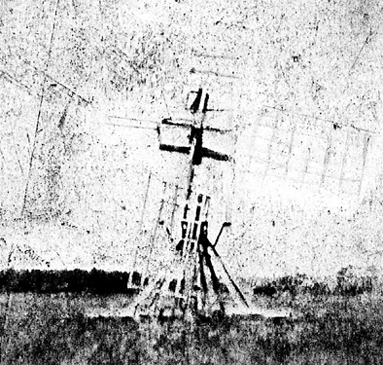 |
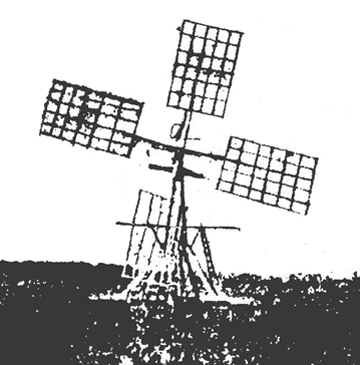 |
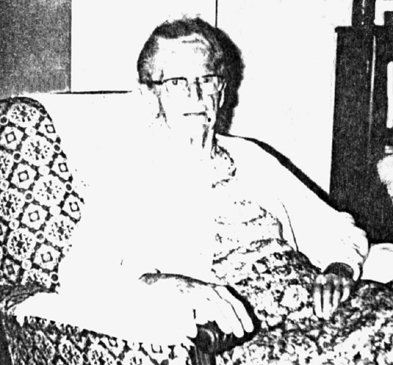 |
| This undated, faded photograph was given to Gladys Ives Sadler Holton by Sina Lupton Carawan, seen at far right | Using the original picture of the windmill as a basis, Odell Spain’s drawing shows what the windmill probably looked like. | Sina Lupton Carawan (1885-1983), daughter of Andrew Jackson Lupton & Sarah Jane Thornton. Picture taken June 1981. |
|
The Grindstones |
|||
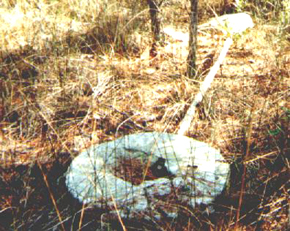 |
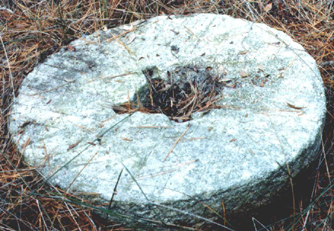 |
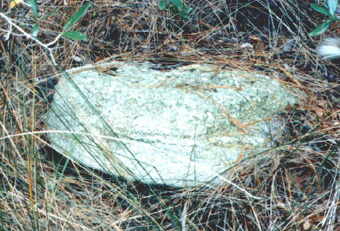 |
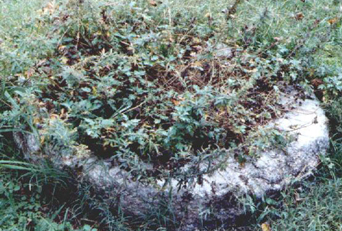 |
| Stephen Jones left pry poles under the old millstone. He was trying to move the stone and gave up after moving it about 10 feet. | Top stone was about 4 feet across and six inches thick. | Bottom stone was at least eight or 10 inches thick. |
Grind stone, with flowers growing out of the center, from the Marcus Carawan mill on the side of Horn Road in Lowland which is now used for a property line marker. |
![]()
© 20
11 Kay Midgett Sheppard